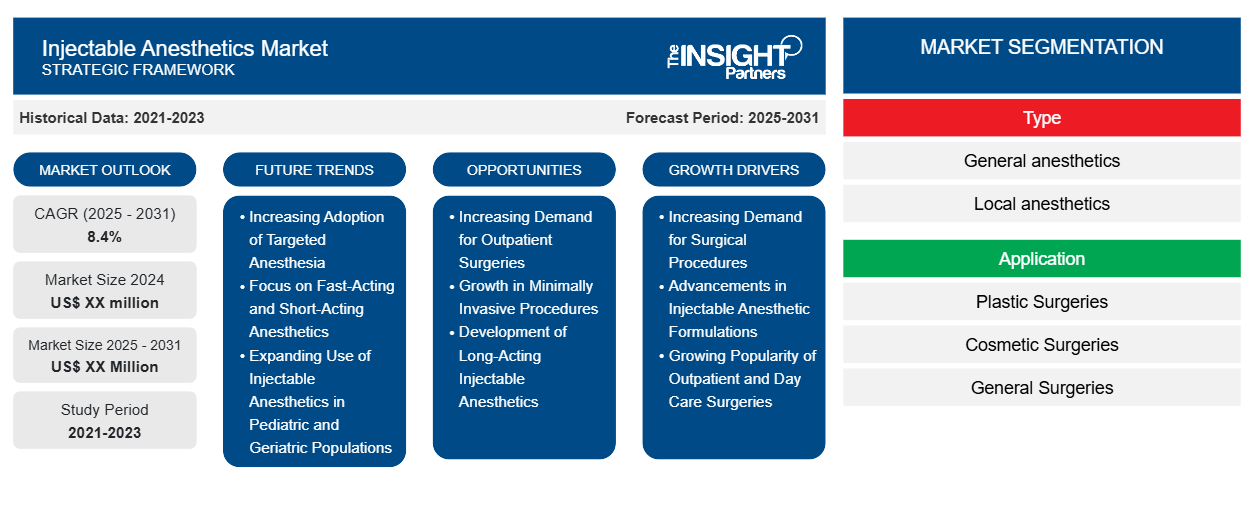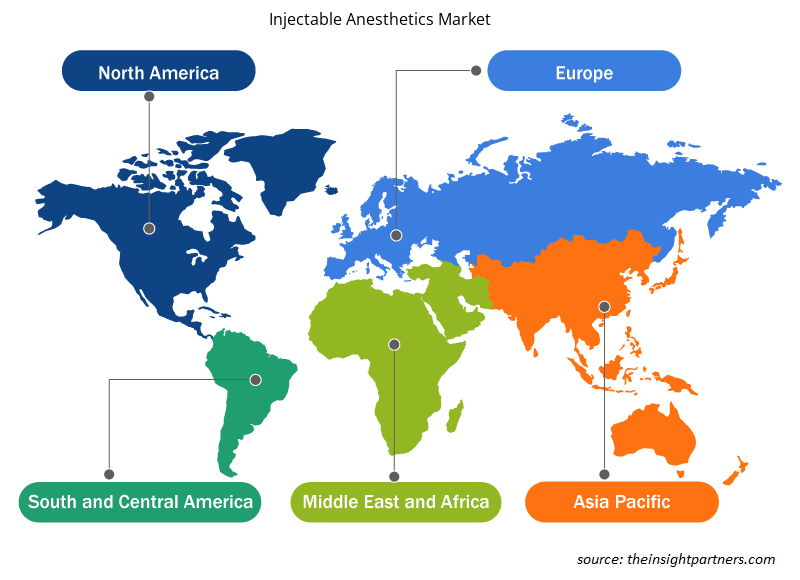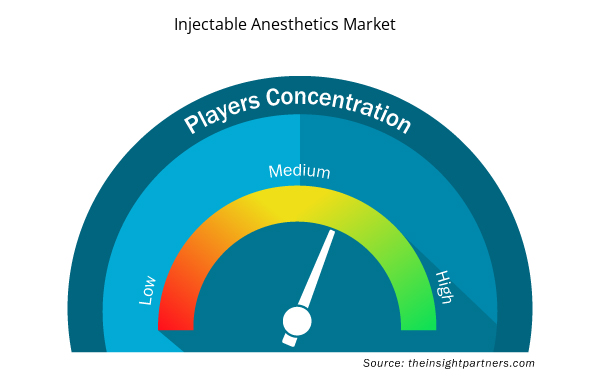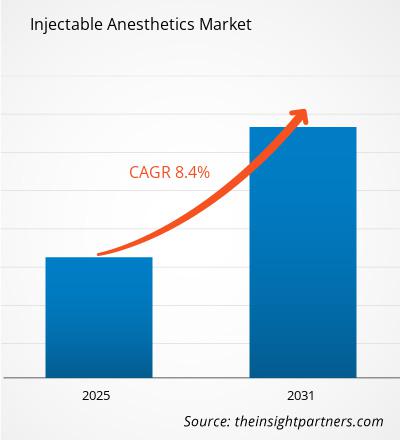The Injectable Anesthetics Market is expected to register a CAGR of 8.4% from 2025 to 2031, with a market size expanding from US$ XX million in 2024 to US$ XX Million by 2031.
The report is segmented by Type (General anesthetics, Local anesthetics); Application (Plastic Surgeries, Cosmetic Surgeries, General Surgeries, Dental Surgeries, Gynecology Surgeries, Others); and End User (Hospitals, Clinics, Ambulatory Surgical Centers). The global analysis is broken down at the regional level and for major countries. The market evaluation is presented in US$ for the above segmental analysis.
Purpose of the Report
The report Injectable Anesthetics Market by The Insight Partners aims to describe the present landscape and future growth, top driving factors, challenges, and opportunities. This will provide insights to various business stakeholders, such as:
- Technology Providers/Manufacturers: To understand the evolving market dynamics and know the potential growth opportunities, enabling them to make informed strategic decisions.
- Investors: To conduct a comprehensive trend analysis regarding the market growth rate, market financial projections, and opportunities that exist across the value chain.
- Regulatory bodies: To regulate policies and police activities in the market with the aim of minimizing abuse, preserving investor trust and confidence, and upholding the integrity and stability of the market.
Injectable Anesthetics Market Segmentation
Type
- General anesthetics
- Local anesthetics
Application
- Plastic Surgeries
- Cosmetic Surgeries
- General Surgeries
- Dental Surgeries
- Gynecology Surgeries
End User
- Hospitals
- Clinics
- Ambulatory Surgical Centers
Customize This Report To Suit Your Requirement
You will get customization on any report - free of charge - including parts of this report, or country-level analysis, Excel Data pack, as well as avail great offers and discounts for start-ups & universities
Injectable Anesthetics Market: Strategic Insights

- Get Top Key Market Trends of this report.This FREE sample will include data analysis, ranging from market trends to estimates and forecasts.
Injectable Anesthetics Market Growth Drivers
- Increasing Demand for Surgical Procedures: The rising number of surgeries worldwide represents a significant growth opportunity for the injectable anesthetics market. As healthcare systems improve, especially in emerging economies, there is a notable increase in both elective and non-elective surgical procedures. These surgeries span various fields such as orthopedic, cardiovascular, neurological, and cosmetic surgeries, all of which require effective anesthesia management. Injectable anesthetics play a crucial role in ensuring that surgeries are performed smoothly and safely, as they are commonly used for general anesthesia during operations. In particular, minimally invasive surgeries and outpatient procedures have seen a dramatic rise due to their shorter recovery times and reduced complications. These types of procedures often require short-acting injectable anesthetics, creating an ongoing demand for fast-onset, efficient formulations. Additionally, the aging global population is increasing, which contributes to a rise in age-related surgeries, including joint replacements, cataract surgeries, and cardiac interventions, thus driving the need for anesthesia products. As more patients undergo surgical procedures in both developed and emerging markets, the demand for injectable anesthetics will continue to grow. Countries in regions like Asia-Pacific, Latin America, and the Middle East are witnessing improvements in healthcare access and infrastructure, which further contribute to the rising number of surgeries. This provides manufacturers with a growing market of patients and healthcare providers in need of safe, effective injectable anesthetic solutions to manage surgical procedures efficiently.
- Advancements in Injectable Anesthetic Formulations: Ongoing advancements in injectable anesthetic formulations represent a significant growth opportunity for the market, as these innovations continue to improve patient outcomes and expand the range of surgeries that can be performed. For example, long-acting and ultra-long-acting injectable anesthetics are becoming more popular for improving post-operative pain management. These formulations reduce the need for multiple doses of anesthetic agents during and after surgery, leading to enhanced patient comfort, quicker recovery times, and lower risks of complications. Furthermore, formulations that allow for faster onset and smoother recovery are increasingly in demand, especially in outpatient or same-day discharge surgeries. These formulations can provide better control of anesthesia depth while minimizing the duration of the anesthetic’s effects, which is ideal for procedures requiring shorter recovery periods. Additionally, as the understanding of patient-specific factors such as age, weight, and health conditions deepens, there is a growing focus on creating highly personalized injectable anesthetic products. Advanced formulations can be tailored to specific surgeries or patient needs, offering a more precise and safer experience. Companies that innovate in this area, particularly in developing safer anesthetic agents with fewer side effects, will be well-positioned to capture market share. As the demand for minimally invasive procedures grows and patients seek more efficient recovery, injectable anesthetics that provide greater precision and fewer adverse effects will become more essential, fueling growth in the market.
- Growing Popularity of Outpatient and Day Care Surgeries: The increasing preference for outpatient and day care surgeries is a key growth opportunity in the injectable anesthetics market. Outpatient surgeries, which allow patients to return home on the same day, have become increasingly popular due to their convenience, cost-effectiveness, and shorter recovery times. These types of surgeries require efficient and precise anesthesia, which makes injectable anesthetics ideal for such procedures. With a rise in minimally invasive and less complex surgeries, injectable anesthetics are being used more frequently for their ability to provide rapid onset and short-acting anesthesia, reducing the time spent in the recovery room. Common examples include cataract surgeries, cosmetic procedures, and some orthopedic operations. As healthcare systems aim to reduce costs while improving patient outcomes, outpatient surgeries are expected to become more prevalent. Injectable anesthetics that offer quick recovery and minimal side effects are ideal for these types of procedures, as patients can be safely discharged on the same day. Additionally, technological advancements such as enhanced monitoring systems during surgery allow for more efficient and controlled anesthesia delivery. The shift toward outpatient surgery models is also supported by the growing demand for minimally invasive procedures, as they generally require fewer resources and have lower risks compared to traditional open surgeries. This trend presents a significant opportunity for injectable anesthetic manufacturers to innovate in creating products tailored to the specific needs of outpatient and day care surgeries, ensuring safe, quick, and effective anesthesia management.
Injectable Anesthetics Market Future Trends
- Increasing Adoption of Targeted Anesthesia: The growing trend of targeted or personalized anesthesia is poised to significantly impact the injectable anesthetics market in the coming years. Personalized anesthesia aims to customize the type, dose, and delivery method of anesthetics based on a patient’s unique physiological needs. This approach ensures that the right amount of anesthetic is administered to achieve the optimal level of sedation while minimizing potential side effects. Advances in monitoring technologies, such as depth-of-anesthesia monitoring and continuous electroencephalogram (EEG), are playing a key role in making targeted anesthesia a reality. These technologies allow anesthesiologists to monitor real-time brain activity, adjusting the anesthetic dosage to maintain the desired level of sedation throughout the procedure. Additionally, the integration of artificial intelligence (AI) and machine learning (ML) algorithms in anesthesia management is expected to become more common. These tools can analyze vast amounts of patient data, including vital signs and medical history, to predict how a patient might respond to specific anesthetics and adjust the treatment accordingly. This trend is particularly important for high-risk patients or those with complex medical conditions, as personalized anesthesia can improve patient safety and reduce the risk of complications. As both healthcare providers and patients demand more tailored, safe, and effective treatments, the injectable anesthetics market will see an increased shift toward targeted anesthesia, fueling future market growth and innovation.
- Focus on Fast-Acting and Short-Acting Anesthetics: The development and growing demand for fast-acting and short-acting injectable anesthetics is a key trend shaping the future of the market. As the healthcare industry moves toward minimally invasive procedures, which require faster recovery times and shorter anesthesia durations, there is a clear preference for anesthetics that allow patients to emerge from sedation quickly and with minimal side effects. Short-acting anesthetics, such as propofol and remifentanil, are gaining popularity for their ability to induce rapid onset and offset of anesthesia. These agents enable healthcare providers to better control the depth of anesthesia, reducing the time patients spend in the recovery room and allowing for quicker discharges from the hospital. Fast-acting injectable anesthetics also minimize the risk of side effects such as nausea, vomiting, and prolonged sedation, which can be particularly problematic in outpatient or same-day discharge surgeries. Furthermore, short-acting anesthetics provide greater flexibility during procedures, enabling anesthesiologists to adjust dosages more easily and quickly, which is crucial for minimally invasive and precise surgeries. With the rising demand for outpatient surgeries and diagnostic procedures, the need for anesthetics that offer rapid recovery is becoming more important. This trend is expected to drive the development of new injectable anesthetic formulations that can provide efficient and rapid anesthesia for a wide range of procedures, helping to enhance patient outcomes and satisfaction.
- Expanding Use of Injectable Anesthetics in Pediatric and Geriatric Populations: The growing use of injectable anesthetics in both pediatric and geriatric populations is a crucial trend for the market’s future. Pediatric and geriatric patients present distinct challenges in anesthesia administration, and as the global population continues to age and as pediatric surgeries increase, the need for safe and effective anesthetic agents for these groups will grow. In pediatric patients, anesthetics need to be carefully dosed based on weight and age to minimize the risk of adverse effects, while geriatric patients often have more complex medical conditions and a lower tolerance to anesthesia. Injectable anesthetics for these populations must be carefully formulated to ensure patient safety, particularly for elderly individuals who may experience complications such as cardiovascular instability or renal issues. Advances in drug delivery systems, such as more precise dosing methods and less invasive injection techniques, are expected to make injectable anesthetics safer and more effective for these vulnerable populations. Additionally, as medical treatments for older adults improve, more elective surgeries will be performed on seniors, further increasing the demand for specialized injectable anesthetic solutions. The pediatric and geriatric segments are expected to see increased investments from pharmaceutical companies, with a focus on developing anesthetics that are not only effective but also gentle and safer for these age groups. This trend will help propel growth in the injectable anesthetics market, as the healthcare system adapts to meet the specific needs of both young and elderly patients.
Injectable Anesthetics Market Opportunities
- Increasing Demand for Outpatient Surgeries: The rising popularity of outpatient surgeries represents a key growth opportunity for the injectable anesthetics market. Outpatient surgeries, which allow patients to go home on the same day, are becoming more common due to their cost-effectiveness and shorter recovery times. These procedures often require anesthetics that provide quick onset, precise control, and rapid recovery, which is where injectable anesthetics excel. Injectable anesthetics, such as propofol and remifentanil, offer the ideal combination of fast action and minimal side effects, making them the preferred choice for outpatient surgeries like cataract procedures, cosmetic surgeries, and dental interventions. As healthcare systems worldwide emphasize reducing patient hospitalization times and optimizing healthcare costs, the demand for outpatient surgeries is expected to continue growing. Additionally, with the aging population and the increased prevalence of chronic conditions, the number of patients seeking minimally invasive outpatient procedures is likely to rise. Injectable anesthetics are crucial for these procedures as they allow for tailored anesthesia management, ensuring patients remain comfortable while minimizing the risk of complications. This shift in healthcare delivery presents a significant opportunity for anesthetic manufacturers to innovate in developing injectable agents specifically designed for outpatient and same-day discharge surgeries, capturing a growing segment of the market.
- Growth in Minimally Invasive Procedures: Minimally invasive surgeries, which require smaller incisions and offer quicker recovery times, are on the rise, creating a substantial growth opportunity for the injectable anesthetics market. These procedures, including laparoscopic surgeries, endoscopic surgeries, and robotic-assisted surgeries, have become more popular due to their ability to reduce pain, minimize scarring, and shorten recovery periods. The demand for injectable anesthetics is increasing in these surgeries because they offer rapid onset and recovery, essential for these types of operations. Injectable anesthetics such as propofol, dexmedetomidine, and remifentanil are particularly suitable for minimally invasive surgeries because they allow for fine-tuned control over sedation, ensuring optimal patient comfort while maintaining minimal levels of anesthesia. The popularity of these procedures has been growing in fields such as orthopedics, neurology, and gynecology, where patients prefer these less invasive options due to the reduced risk of complications and faster recovery. As the number of minimally invasive surgeries continues to rise, the demand for injectable anesthetics is expected to grow as well, presenting an opportunity for manufacturers to develop formulations that can further optimize the anesthetic experience for patients undergoing these types of procedures. In particular, injectable anesthetics that offer more precise dosing and quicker recovery times will be highly sought after by healthcare providers and patients alike.
- Development of Long-Acting Injectable Anesthetics: The growing demand for long-acting injectable anesthetics presents a significant opportunity for market growth, particularly for post-operative pain management. Long-acting anesthetics are increasingly important for surgeries where prolonged pain relief is necessary, such as major orthopedic or abdominal surgeries. These anesthetics can help reduce the need for additional pain management medications, lower the risk of opioid dependency, and enhance patient comfort during recovery. For instance, newer formulations of local anesthetics, such as liposomal bupivacaine, are designed to provide extended pain relief by gradually releasing the anesthetic over time. This trend is especially relevant in outpatient or same-day discharge settings, where patients benefit from sustained pain relief post-surgery but are able to recover and leave the hospital sooner. The rise in chronic pain management and the emphasis on reducing opioid use has driven the development of more long-acting injectable anesthetic formulations. These products are increasingly used in combination with other pain management strategies to reduce the need for opioid medications. With the push for opioid-free pain management solutions and the rising prevalence of surgeries, particularly in the aging population, the market for long-acting injectable anesthetics is expected to grow substantially. Manufacturers focusing on this area have a significant opportunity to innovate by creating new long-acting anesthetics that enhance recovery and reduce the reliance on opioids, improving both patient outcomes and satisfaction.
Injectable Anesthetics Market Regional Insights
The regional trends and factors influencing the Injectable Anesthetics Market throughout the forecast period have been thoroughly explained by the analysts at Insight Partners. This section also discusses Injectable Anesthetics Market segments and geography across North America, Europe, Asia Pacific, Middle East and Africa, and South and Central America.

- Get the Regional Specific Data for Injectable Anesthetics Market
Injectable Anesthetics Market Report Scope
| Report Attribute | Details |
|---|---|
| Market size in 2024 | US$ XX million |
| Market Size by 2031 | US$ XX Million |
| Global CAGR (2025 - 2031) | 8.4% |
| Historical Data | 2021-2023 |
| Forecast period | 2025-2031 |
| Segments Covered |
By Type
|
| Regions and Countries Covered | North America
|
| Market leaders and key company profiles |
Injectable Anesthetics Market Players Density: Understanding Its Impact on Business Dynamics
The Injectable Anesthetics Market market is growing rapidly, driven by increasing end-user demand due to factors such as evolving consumer preferences, technological advancements, and greater awareness of the product's benefits. As demand rises, businesses are expanding their offerings, innovating to meet consumer needs, and capitalizing on emerging trends, which further fuels market growth.
Market players density refers to the distribution of firms or companies operating within a particular market or industry. It indicates how many competitors (market players) are present in a given market space relative to its size or total market value.
Major Companies operating in the Injectable Anesthetics Market are:
- Abbott
- Baxter international,
- F. Hoffmann-La Roche,
- AstraZeneca,
- B. Braun Melsungen AG,
- AbbVie Inc.,
Disclaimer: The companies listed above are not ranked in any particular order.

- Get the Injectable Anesthetics Market top key players overview
Key Selling Points
- Comprehensive Coverage: The report comprehensively covers the analysis of products, services, types, and end users of the Injectable Anesthetics Market, providing a holistic landscape.
- Expert Analysis: The report is compiled based on the in-depth understanding of industry experts and analysts.
- Up-to-date Information: The report assures business relevance due to its coverage of recent information and data trends.
- Customization Options: This report can be customized to cater to specific client requirements and suit the business strategies aptly.
The research report on the Injectable Anesthetics Market can, therefore, help spearhead the trail of decoding and understanding the industry scenario and growth prospects. Although there can be a few valid concerns, the overall benefits of this report tend to outweigh the disadvantages.
- Historical Analysis (2 Years), Base Year, Forecast (7 Years) with CAGR
- PEST and SWOT Analysis
- Market Size Value / Volume - Global, Regional, Country
- Industry and Competitive Landscape
- Excel Dataset


- Latent TB Detection Market
- Virtual Pipeline Systems Market
- Ketogenic Diet Market
- Embolization Devices Market
- Bio-Based Ethylene Market
- Piling Machines Market
- Hydrogen Storage Alloys Market
- Automotive Fabric Market
- Health Economics and Outcome Research (HEOR) Services Market
- Portable Power Station Market

Report Coverage
Revenue forecast, Company Analysis, Industry landscape, Growth factors, and Trends

Segment Covered
This text is related
to segments covered.

Regional Scope
North America, Europe, Asia Pacific, Middle East & Africa, South & Central America

Country Scope
This text is related
to country scope.
Frequently Asked Questions
The Injectable Anesthetics Market is estimated to witness a CAGR of 8.4% from 2025 to 2031.
The major factors driving the Injectable Anesthetics Market are Increasing Demand for Surgical Procedures, Advancements in Injectable Anesthetic Formulations, and Growing Popularity of Outpatient and Day Care Surgeries.
Future trends in the Injectable Anesthetics Market are Increasing Adoption of Targeted Anesthesia, Focus on Fast-Acting and Short-Acting Anesthetics, Expanding Use of Injectable Anesthetics in Pediatric and Geriatric Populations.
Some of the players operating in the market are Abbott, Baxter international, F. Hoffmann-La Roche, AstraZeneca, B. Braun Melsungen AG, AbbVie Inc., Fresenius SE & Co. KgaA, Mylan N.V., Hikma Pharmaceuticals PLC, Teva Pharmaceuticals.
The report can be delivered in PDF/PPT format; we can also share an excel datasheet based on the request.
Some customization options available based on the request are an additional 3–5 company profiles and a country-specific analysis of 3–5 countries of your choice. Customizations are to be requested/discussed before making final order confirmation# as our team would review the same and check the feasibility.
Trends and growth analysis reports related to Life Sciences : READ MORE..
1. Abbott
2. Baxter international
3. F. Hoffmann-La Roche
4. AstraZeneca
5. B. Braun Melsungen AG
6. AbbVie Inc
7. Fresenius SE & Co. KgaA,
8. Mylan N.V.,
9. Hikma Pharmaceuticals PLC,
10. Teva Pharmaceuticals

 Get Free Sample For
Get Free Sample For